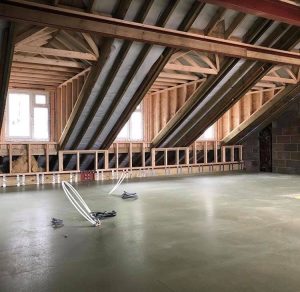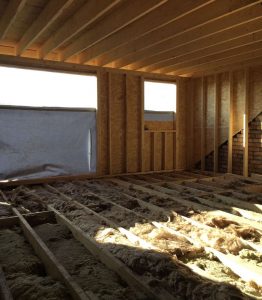02 Aug What is the Best Insulation for a Loft Conversion?
Insulating a loft, attic, or other roof structure is key to helping reduce the heat that is lost through a building’s roof. By reducing the heat lost through the roof of a property, billpayers enjoy reduced energy bills and more comfortable indoor temperatures during cold months.
When the correct variety of insulation is installed correctly, billpayers may see a significant reduction in their heating costs! As with any construction component there is a wide variety of insulation types to choose from, and choosing the best kind is important for delivering optimal results.
Factors such as access, size, and possible existing damp or condensation can influence which type of insulation is most suitable for your property. In this blog from Turner’s Lofts, we outline a variety of different options for loft insulation, noting the key properties of each.
Get in touch for a free assessment!
How Does Loft Insulation Work?
Loft insulation works by preventing the movement of heated air through the insulation material. As heated air moves, it becomes trapped in the fibres of the insulation material, preventing its escape.
For maximum effectiveness, loft insulation should be installed before or at the same time as a new heating system. Loft insulation and heating should always be considered in combination as the degree of insulation present may influence the heating system that a building requires. If a sophisticated insulation system is in place, saving money on cheaper heating equipment may be possible.
In addition to reducing heat loss and energy bills, installing insulation also has other benefits including being more environmentally friendly and increasing the overall value of your home.
A Note on Ventilation
When selecting the right insulation for your project, ventilation is also a factor to be considered. Ventilation and insulation work together to keep a space warm and breathable. When creating a loft space, adequate insulation is essential to ensure that condensation does not develop.
Special attention must be paid to ensuring openings into the loft from the eaves are not blocked. If a space is particularly large, additional measures may be required to maximise ventilation.
Need to budget for your loft conversion? Learn how with our guide. >
What are the Different Types of Loft Insulation?
The best insulation for a loft conversion depends on the specifics of the build, so it’s important to know where each insulation is optimally used. In this section, we have provided a selection of the insulation varieties available for loft conversions – noting their individual properties, benefits, and drawbacks.
Blanket Loft Insulation
Blanket insulation is an especially common variety of insulation – often coming in rolls of rock, glass or mineral fibre. Blanket insulation offers an affordable option for all-purpose insulation.
When used within a loft conversion, blanket insulation boasts a number of advantages, including:
- Thermal insulation
- Acoustic insulation
- Heat loss reduction through convection prevention
- Low maintenance
- Fire-resistant properties
- Safety benefits
Blanket insulation is typically installed in unfinished walls, floors, and ceilings. The batts or rolls of insulation are laid within the internal partitions between joists for maximum effectiveness. It is notable that the space between joists must be clear of obstructions such as wires or piping to ensure safe installation.
We offer solutions for loft conversions of all shapes and sizes. Get started with us today!
Loose Fill Loft Insulation
Loose fill loft insulation is made up of loose, lightweight material such as cork granules, cellulose fibre, mineral wool or recycled newspaper. Loose fill insulation is versatile in its ability to be used both alone and as a ‘top-up’ for existing insulation. Loose-fill insulation products are ideal for use in contexts where there may be access challenges, for example below pitched roofs and above gabled dormers.
Where there are no access challenges, installation of loose-fill insulation is fast and easy to carry out. The installation process involves using a length of tubing and an industrial blower. The tube is then run from the ground into the attic with one installer feeding the material in and the other directing the other end of the tube in the attic. Both individuals involved in the installation of loose-fill insulation must wear the appropriate protective clothing.
While installation can be quick and easy, many experts note that over-fluffing fibres can reduce the effectiveness of insulation. Loose-fill loft insulation is also subject to coming loose in draughty lofts.
Sheet Loft Insulation
Sheet loft insulation offers an ideal solution for insulating the underside of a roof – offering an especially fitting solution for sloped roofs. Sheet loft insulation comes in the form of firm boards that not only provide a great insulation solution for your loft but may also be decorated for visual appeal – some sheets can even be purchased pre-decorated.
Some providers also offer sheet insulation with fire or moisture-resistant coating. Naturally, different varieties of sheet insulation come at different prices – however, sheet insulation is considered an overall more expensive insulation solution.
Loft Conversions with Turner’s Lofts
Adding a loft conversion to your property can be a great way of adding space and value. Ensuring that you install the correct loft insulation will help you make the most of your new space.
At Turner’s Lofts, we specialise in loft conversions and can provide you with a full-service solution to take care of every aspect of your project. From planning permission and building regulations to party wall agreements and construction, we have the experience and expertise to ensure your loft conversion meets all of the necessary requirements and exceeds your expectations.
Get the ball rolling on your loft conversion project by contacting one of our friendly team members. Alternatively, take a look at our work to get a better understanding of the work we have done, or read some related articles.
Catch up on loft conversion planning permission with our ultimate guide. >
Make sure you understand the building regulations around loft conversions with our blog post. >



Sorry, the comment form is closed at this time.